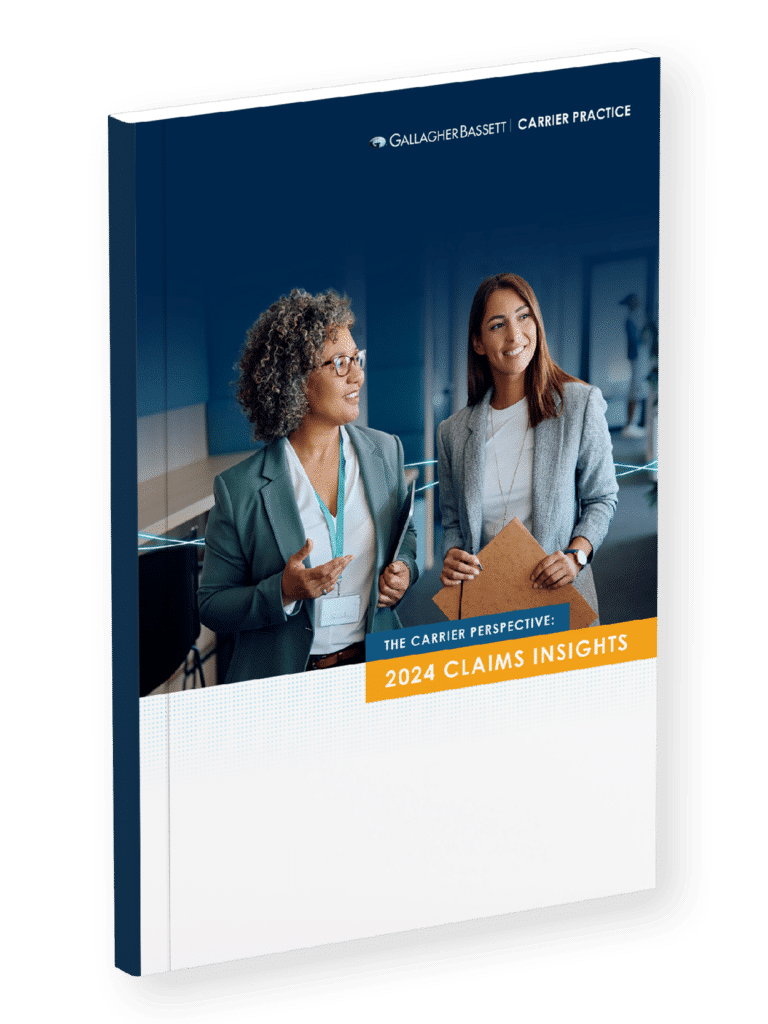As part of our early celebrations of International Women’s Day 2023, several of our Gallagher Bassett (GB) female leaders and experts offer insights into technology and analytics in the carrier marketplace and pursuing a career in insurance.
The insurance industry has entered the next stage of digital transformation, and with technology trends tipped to be one of the biggest topics of 2023, it’s important to know what this means for carriers. We spoke with Megan Nelson (AVP—Operation Insights & Analytics), Jessy Watson (AVP—Consultative Analytics), Sandra Nikodimos (Senior Associate—Consultative Analytics), and Jennifer Turner (SVP RMIS Solutions) to find out how GB is empowering clients to be on the cutting edge of the industry.
How did you get started in the insurance industry?
Jessy Watson (JW): Insurance is not an industry that people tend to actively seek out. I was a single parent looking for a stable career with great benefits, and a large carrier had offices in my city. In terms of analytics, I had experience in cost accounting, supply chain management, and purchasing, which gave me ample experience in business analysis. Through opportunities at that carrier, I was able to grow my insurance knowledge and transition quickly into analytics, where I could expand my skills from simply performing analysis on provided data to generating logic and queries to gather my own. This later expanded to working with others to build data warehouses, support new models, design new tools, and lead analysts.
Sandra Nikodimos (SN): This was my first job after completing my MBA. I did not have prior experience in the industry, but this exposure taught me a lot, and now I love it. GB invests in new associates and provides an opportunity for more than a job.
Megan Nelson (MN): I started in the industry as an intern at GB and could immediately envision building a long and rewarding career. Every day since then brought new challenges and growth opportunities, and I continue to see this as an industry where I can thrive while making a positive impact on the world and my community.
Jennifer Turner (JT): I was recruited by a large carrier specifically for my out-of-industry data and technology experience. I came from a global healthcare company where I spent five years doing internal controls consulting, primarily in Europe, and then I led the financial systems for North America, reporting to the CFO. This carrier recruited me to build a team and replace their RMIS, which was much more than a traditional RMIS, as it had underwriting, claim management, risk management, and financial stakeholders. It was also deployed to the external insured clients. This began my second career in insurance, specifically in the RMIS market. I have since worked for third-party administrators (TPA) and a global broker prior to joining GB.
What do you think is the most valuable skill for working in data and analytics?
JW: Curiosity is the hallmark of any good analyst. We are infinitely curious to understand “the why,” which is what separates analysis from reporting. Being able to serve as a translator between any business and the data that represents it is invaluable. Finally, in the absence of clearly defined data, great analysts figure out how a question may and should be answered.
SN: I think the most valuable skill in analytics is the ability to process large data sets and understand what the numbers are telling you. I like the fact that the problems we face are challenging and dynamic, which is why it is necessary to love solving problems every day.
MN: I believe the most valuable skill for those working in the data and analytics space is the ability to simply communicate complex topics to any audience. Far too often, the conversation becomes complex and intimidating when data and analytics are introduced. It is our responsibility as data experts to make insights accessible to all our stakeholders.
What are some industry trends you think are going to impact our clients/carriers?
JW: The big differentiator now is not what we do but the experience that insureds, claimants, and other parties bring into the process. We live in a smart, connected society, and how we go about the business of insurance (and examine such via analytics) has to align. As an example, when looking to claim financials, using operational data and experience not only gives a more holistic point of view but allows clients and carriers to impact those same financials by addressing identified operational- and experience-oriented opportunities that may have been previously missed.
MN: Organizations are encountering change at a more rapid pace than ever. This trend is only going to accelerate, and that creates an enormous amount of risk. At GB, we have the right people, expertise, and capabilities to partner with employers and carriers to ensure they are prepared and armed with the right tools to face any risk confidently.
Are there tools that you have seen our clients use that get you excited about the future of data and analytics?
JW: Working for GB, I have seen modeling used to directly inform daily decision-making, which is a change from what I saw in other organizations. Our predictive models such as Waypoint and SMART benchmarking being integrated into alerts for recognizing claim opportunities and putting that information directly to those handling and reviewing the claims provides the opportunity to “turn the ship around” in real time if needed.
JT: GB’s award-winning RMIS platform Luminos is a great place to start, as it is our one-stop-shop portal for all our client-facing products. We have created a unique hybrid RMIS solution. Alongside core RMIS software features, we draw from our own repository of claim expertise and data science resources to provide a full suite of data benchmarks, scorecards, and AI-driven predictive analytics that deliver actionable information to our carrier partners.
MN: I work closely with our decision-support products at GB and am excited about how receptive clients have been about adopting these tools to ensure we have the right resources on the right claims at the right time. By strategically leveraging decision-support tools, GB selectively deploys clinical resources to protect our clients’ brands, advocate for their claimants, and deliver superior outcomes.
Over the last few years, we have experienced a lot of change in the industry—have you seen changes in the types of decision-support tools our clients leverage?
JW: I have seen fewer changes in the types of tools our clients need and leverage but rather more changes to how they need to be able to use and leverage them. Being able to customize those tools, use them proactively, and work with analytics teams that understand and accommodate needs for increased autonomy or support have become increasingly prevalent.
MN: At GB, our decision-support tools combine the best of our people’s expertise with the breadth of our claims data. By combining the strengths of our human and artificial intelligence, we can provide more effective decision support for our claims and client partners. This approach also provides us with a feedback loop that invites experimentation and facilitates improvements to our solutions to promote learning and adapting to an ever-changing environment.
JT: Historically, RMIS products needed to meet today’s risk management challenges were unavailable in the bundled TPA marketplace. Much of the focus was centered on rudimentary claims management and after-the-fact claims reporting, such as loss runs. With maturing risk and claims management disciplines, the focus has shifted to improving outcomes and program performances. There is certainly no shortage of disparate total cost of risk (TCOR) data sets currently stored globally in mainframe computers, desktop spreadsheets, and cloud environments. While many organizations excel at stockpiling transactional data in massive data warehouses, those that truly lead their sectors have successfully tapped into the actual context and meaning of their risk management information, driving deliberate decisions and actions that lower their TCOR.
When supporting our partners with data, analytics, and tools, what matters most?
JW: There are times when our partners may be asking for specific analysis, data, or tools that they think will support their objectives. As analytics professionals, we are responsible for triaging those needs, getting to “the why” behind the requests, and recommending the appropriate solutions accordingly. What matters most is listening to understand and providing the appropriate solutions to our partners based on our expertise in analytics and their objectives rather than delivering only exact requests.
SN: We are overloaded with data these days, and it is easy to get lost in the numbers, so interpreting data correctly and focusing on what matters most is important. It also enables our claims resolution managers and supervisors to have more rewarding careers and dive deeper into issues to drive superior outcomes impacting injured workers, claimants, attorneys, and other constituents.
MN: Understanding what is important to our partners and meeting them where they are is critical. It is easy to feel overwhelmed in this environment where data are abundant, and the best way we can support our partners is by using data to simplify how they make everyday decisions.
JT: It is critical when a carrier partners with a TPA that the TPA can provide RMIS product suites that include all the data inquiry, transactional reporting, and advanced interactive analytics required to successfully manage business risks and insured enterprise-wise liabilities. Our clients need to focus on their core business, and they expect us to care for their technology and data needs. This requires flexible technologies and a relentless drive for product innovation. We are always thinking about how to merge our claims expertise and computing technologies with our ecosystem of tools to deliver the robust products that matter most.
Contact our team today and find out how we can support you this year.





